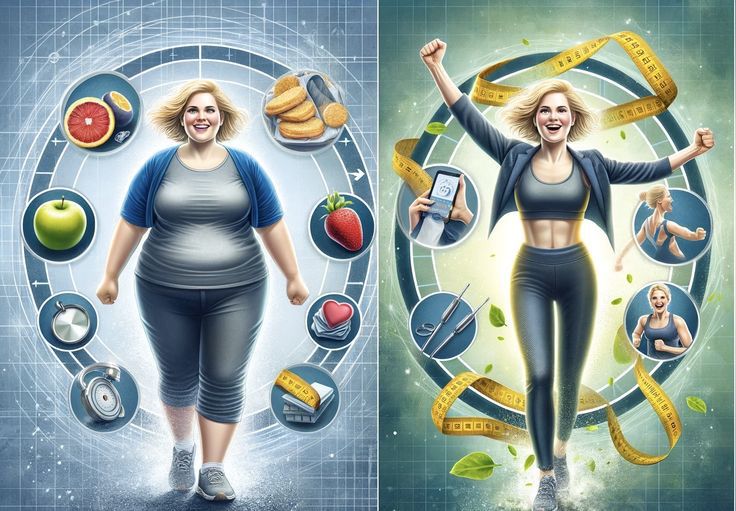Training and living a healthy lifestyle involve most people trying to attain a perfect body. Usually, this takes the form of weight loss, but the better, albeit more detailed and eventually successful concept is referred to as, body recomposition. This movement changes the idea of focusing at the number on the scale, but considers the very composition of your body, with the idea of losing fat, and gaining muscles at the same time.
What is Body Composition?
Body composition refers to the percentages of fat, bone, water, and muscle in the human body. Unlike weight alone, which simply measures how heavy you are, body composition provides deeper insight into how healthy your body truly is by showing what your body weight consists of.
Key Components of Body Composition
Body Fat Mass
- This includes both essential fat (needed for normal body functioning) and storage fat (excess fat stored in fat cells).
- Essential fat is found in organs, muscles, and the central nervous system. It is crucial for hormone production and temperature regulation.
- Storage fat is energy reserved in adipose tissue. Too much of it, especially around the abdomen (visceral fat), can increase the risk of chronic diseases.
Lean Body Mass (LBM)
- This includes muscles, bones, organs, and water everything in the body that is not fat.
- LBM is critical for mobility, strength, and metabolic rate. More lean mass means you burn more calories even at rest.
Muscle Mass
- Part of lean body mass, muscle is essential for strength, endurance, and physical performance.
- Increasing muscle mass improves metabolic health and reduces injury risk.
Bone Mass
- Represents the amount of bone mineral in your body.
- Healthy bone mass supports structural integrity and reduces the risk of osteoporosis.
Water Content
- Your body is about 50–65% water. Hydration impacts digestion, brain function, and overall health.

Why Body Composition Awareness Matters?
Weight Is Not Enough: Two people can weigh the same but have very different body compositions. One might have higher muscle mass and low fat, while the other might have high fat and low muscle.
Better Health Marker: High body fat especially visceral fat correlates strongly with conditions like heart disease, type 2 diabetes, and certain cancers.
Track Progress Accurately: When losing weight, it’s important to know if you’re losing fat, water, or muscle. Maintaining or gaining muscle while losing fat is ideal.
Improves Fitness Planning: Tailoring your workouts and nutrition based on body composition can yield better, personalized results.
How to Measure Body Composition?
There are several methods to assess body composition, each varying in accuracy and availability:
- Bioelectrical Impedance Analysis (BIA)
- Common in fitness centers and smart scales.
- Sends a weak electrical current through the body; fat resists the current more than muscle or water.
- Pros: Easy and fast.
- Cons: Can be affected by hydration, meal timing, and device quality.
- Dual-Energy X-ray Absorptiometry (DEXA)
- Gold standard method used in medical and research settings.
- Provides detailed breakdown of fat, muscle, and bone.
- Pros: Highly accurate.
- Cons: Expensive and requires medical equipment.
- Skinfold Calipers
- Measures subcutaneous fat at various body sites.
- Requires trained personnel for accuracy.
- Pros: Low cost and portable.
- Cons: Accuracy depends on technique.
- Hydrostatic Weighing
- Measures body density by submerging a person in water.
- Pros: Very accurate.
- Cons: Inconvenient and not widely available.
- Air Displacement Plethysmography (Bod Pod)
- Measures air displacement in a chamber to estimate body composition.
- Pros: Comfortable and accurate.
- Cons: Expensive and rare in local gyms.
Healthy Body Composition Goals
General healthy body composition fat percentage ranges vary by age and gender.
| Group | Healthy Fat % (Women) | Healthy Fat % (Men) |
|---|---|---|
| Athletes | 14–20% | 6–13% |
| Fitness | 21–24% | 14–17% |
| Average | 25–31% | 18–24% |
| Obese | 32%+ | 25%+ |
Note: Individual goals may vary based on age, genetics, and health conditions.
What is the Body Recomposition?
Body recomposition is when you alter the fat to muscle ratio of your body. As opposed to traditional weight loss where the proportion of fats and muscle may reduce, a body recomposition directly focuses on fats reduction and, through simultaneous muscle growth. This leads to a tighter, apparently more fit, and in most cases healthier body shape, although it does not radically change your weight.

Biological Science of Body Recomposition
To understand how body recomposition works, we must look at:
Energy Balance: The Starting Point
- Traditional Rule:
- Fat loss requires a caloric deficit (burning more calories than consumed).
- Muscle gain typically requires a caloric surplus (extra calories to build new tissue).
- In Recomposition:
- The body selectively uses stored fat for energy while dietary protein and strength training stimulate muscle growth.
- Especially effective in beginners, overweight individuals, and those returning to training after a break.
2. Hormonal Influence
Several hormones play key roles in facilitating fat loss and muscle gain simultaneously:
- Insulin
- Regulates blood sugar and promotes nutrient storage.
- In recomposition, controlled insulin spikes post-workout help drive nutrients into muscle cells rather than fat cells.
- Testosterone
- An anabolic hormone that increases muscle protein synthesis.
- Higher levels improve muscle gain and fat mobilization.
- Growth Hormone (GH)
- Stimulates lipolysis (fat breakdown) and muscle growth.
- Levels increase during deep sleep and high-intensity workouts.
- Cortisol
- A catabolic stress hormone that can promote fat storage and muscle breakdown if chronically elevated.
- Proper sleep, recovery, and stress management are crucial for balancing cortisol.
- Leptin and Ghrelin
- Regulate hunger and satiety.
- Disrupted levels from poor sleep or excessive dieting may affect body recomposition efforts.
3. Muscle Protein Synthesis vs. Muscle Protein Breakdown
- Muscle Protein Synthesis (MPS) is the process of building new muscle tissue.
- Muscle Protein Breakdown (MPB) is the natural breakdown of muscle tissue.
- Net muscle gain occurs when MPS > MPB.
Resistance training + protein-rich meals (especially with leucine) stimulate MPS.
To maximize recomposition, the goal is to keep MPB low and MPS high, especially around workouts and during sleep.
4. Fat Metabolism: Mobilizing Stored Energy
Fat loss occurs when triglycerides stored in fat cells are broken down into free fatty acids (lipolysis), released into the bloodstream, and used as energy.
Key factors in this process:
- Caloric deficit (or selective use of stored fat)
- Hormones like epinephrine, norepinephrine, and growth hormone
- Increased metabolic rate through resistance training
Strength training + high protein intake + mild deficit = optimal fat burning without muscle loss.
5. Nutrient Partitioning: Where Do Your Calories Go?
Nutrient partitioning is your body’s ability to direct nutrients to muscle tissue instead of fat storage.
This is influenced by:
- Training status (more muscle mass = better insulin sensitivity)
- Macronutrient timing (post workout nutrition improves muscle fuel storage)
- Genetics and hormone levels
- Sleep and recovery quality
With proper training and nutrition, your body becomes more efficient at building muscle even in a slight calorie deficit, while drawing fuel from fat stores.
6. Training Adaptation and Muscle Signaling
- Mechanical Tension (from lifting weights) activates mTOR pathway, a central regulator of muscle growth.
- Metabolic Stress and muscle damage further stimulate growth and adaptation.
- At the same time, increased mitochondrial activity (especially from cardio or HIIT) improves fat oxidation and energy efficiency.
The Essential Nature of Nutrition
Probably nothing is more important in effective body recomposition than nutrition. Training cannot beat bad nutrition.

Calorie Deficit VS Calorie Surplus
With body recomposition, the classical model consists of a small deficit or maintenance calories.
Caloric Deficit: You tend to need to exercise more calories than you take so that you can lose fat. But in case of body recomposition, it has to be moderate so that energy is available to carry out muscle protein production and rest. An excessive aggression of deficit causes destruction of muscle.
Maintenance Calories: Some people, especially those who have lower body fat percentages or are new to resistance training, are able to recomposition by staying at or slightly above their maintenance calories with especially vigorous training. The body is then able to repartition energy sources and uses fat stores as fuel and develops muscles.
Caloric Surplus (in some): In some occasion, especially in situations where a lifter is advanced, wishing to gain as much muscle as possible without an equally appreciative rise in fat, a small calorie surplus may be used, then cut. But to the majority who want to get both fat loss and muscle gain at once then a surplus is not a good idea.
Macronutrient Equilibrium
Macronutrient (protein, carbohydrates and fats ) ratios are important to body recomposition.
•Protein: This is the number-one. Protein contains those amino acids that will be used in repair and development of muscles. Try to get as much protein as you can, which is usually around 1.6-2.2 g/kg of body weight, more in a deficit and depending on the person.
•Carbohydrates: Carbs are source of energy to the body during the workouts and help in recovery of the muscles. This will depend on the level of activity, but emphasize the more within reach of complex carbohydrates i.e. whole grain foods, fruits, and vegetables.
•Fats: These are necessary to produce hormones as well as our health in general. The amount of healthy fats that you should eat should come in as a moderate portion of your diet and this should be approximately 20-30 percent of the amount of calories that you take on a daily basis. Avocados, nuts, seeds and olive oil are some of the sources which should be focused at.
Meals Schedule
Meal timing can act as an auxiliary factor to a total daily intake of macronutrients.
•Small and Frequent Meals: Others report that smaller, more frequent food consumption assists with satiety and regular supply of the nutrients.
•Pre and Post Workout Nutrition: During the pre workout and post workout, it is also advised to do the protein and carb consumption as it can maximize the effort and recovery. The most effective one is a protein shake after the workout.
•Eat a lot of Protein at Your Meal: Decrease your protein intake at one time and spread it across your meals to maintain a constant supply of amino acids to feed muscle protein synthesis.
Body Recomposition using Compound Exercises with Resistance Training
Compound exercises are multi joint movements that engage multiple muscle groups simultaneously. Examples include:
- Squats – work quads, hamstrings, glutes, core
- Deadlifts – work back, glutes, hamstrings, core, forearms
- Bench Press – targets chest, triceps, shoulders
- Pull-Ups/Chin-Ups – back, biceps, core
- Overhead Press – shoulders, triceps, core
- Barbell Rows – lats, traps, rhomboids, biceps
Weekly Compound Exercise Recomposition Plan
| Day | Focus | Exercises | Sets × Reps |
|---|---|---|---|
| Monday | Lower Body – Strength & Core | Barbell Back Squats | 4 × 6–8 |
| Conventional Deadlifts | 3 × 5 | ||
| Walking Lunges (Dumbbells) | 3 × 12 (each leg) | ||
| Planks | 3 × 1 min | ||
| Tuesday | Upper Body – Pull (Back & Biceps) | Pull-Ups (Assisted if needed) | 4 × 6–10 |
| Barbell Bent-Over Rows | 3 × 8–10 | ||
| Seated Cable Rows / T-Bar Rows | 3 × 10–12 | ||
| Barbell or Dumbbell Bicep Curls | 3 × 12 | ||
| Wednesday | Active Recovery / Rest | Light Cardio, Stretching, Foam Rolling | 20–30 mins |
| Thursday | Upper Body – Push (Chest/Shoulders/Triceps) | Barbell Bench Press | 4 × 6–8 |
| Overhead Barbell Press | 3 × 8 | ||
| Incline Dumbbell Press | 3 × 10 | ||
| Push-Ups (Weighted or Bodyweight) | 3 sets to failure | ||
| Friday | Lower Body – Posterior Chain | Romanian Deadlifts (Dumbbells/Barbell) | 3 × 10 |
| Goblet Squats | 3 × 12 | ||
| Glute Bridges or Hip Thrusts | 3 × 12–15 | ||
| Hanging Leg Raises | 3 × 12–15 | ||
| Saturday | Optional HIIT / Active Recovery | HIIT (Sprint 30s + Walk 90s × 8 rounds) or Circuit (Bodyweight & Kettlebell) | 20–25 mins total |
| OR: Swimming, Yoga, Light Cycling | 30–45 mins | ||
| Sunday | Full Rest | Recovery, Sleep, Meal Prep | — |
Cardiovascular Training to Recompose the Body
Resistance training, body recomposition is a potentially viable alternative to cardiovascular exercise because of the benefits of resistance training to expend calories and enhance cardiovascular health.

Types of Cardiovascular Exercises
A smart recomposition plan may still include cardiovascular training, but the type, intensity, and frequency should be carefully selected based on your goals, training load, and recovery capacity.
1. High-Intensity Interval Training (HIIT)
Definition: HIIT involves alternating short bursts of maximum-effort activity with brief recovery periods.
Examples
- Sprint intervals (e.g., 30 seconds sprint, 1-minute rest)
- Cycling sprints
- Battle ropes circuits
- Jump squats or burpees in time based rounds
Benefits
- High calorie burn in less time
- Induces EPOC (excess post-exercise oxygen consumption)—your body continues to burn calories at an elevated rate after the workout
- Improves cardiovascular capacity and insulin sensitivity
- Preserves lean muscle when paired with strength training
Caution
Due to its high intensity, overusing HIIT especially in combination with heavy resistance training can lead to overtraining, elevated cortisol, and impaired muscle recovery. It should be limited to 2–3 sessions per week.
2. Continuous-State Cardio (Steady-State Cardio)
Definition: Moderate-intensity cardiovascular activity performed continuously for an extended period (20–60+ minutes).
Examples
- Jogging
- Swimming
- Cycling
- Brisk walking
Benefits
- Easier on the joints and central nervous system
- Promotes aerobic conditioning and heart health
- Supports fat metabolism over longer durations
- Ideal for active recovery following heavy resistance training days
Drawback
Burns fewer calories per minute compared to HIIT and may lead to muscle loss if overdone or not supported by adequate protein and strength training.
The Benefit of Sleep in Rest and Recovery
When you sleep, your body restores and rejuvenates muscle tissue, secretes necessary hormones (such as growth hormone and testosterone) and balances out appetite suppressing hormones.
Hormonal Regulation: Sleep deprivation will affect the hormones such as ghrelin (which helps to inspire someone to eat) and leptin (which helps to suppresses the desire to eat) thus it will result in heightened cravings and even possible over eating. It also adversely affects the insulin sensitivity.
Muscle Repair and Growth: Most of the muscle protein synthesis and repair happens during the deep sleep.
Performance: Sleep enhances the amount of energy and focus an individual would have in the gym. At least 7-9 good night sleep. Stick to a regular sleep pattern and develop a favorable sleeping environment.
Final Thoughts
Body recomposition is hard yet such a mind blowing process. It takes time, effort and a healthy lifestyle that comprises smart nutrition, workable, good resistance, strategic cardiovascular and rest. Going into it with the idea in mind of just losing weight, you will not only end up with an objectively more attractive figure, but you will also enhance your health, strength and general metabolic performance to a much greater extent. Accept that it will take you time, record progress often, and become change in the process of body recomposition.

 Medically reviewed by
Medically reviewed by